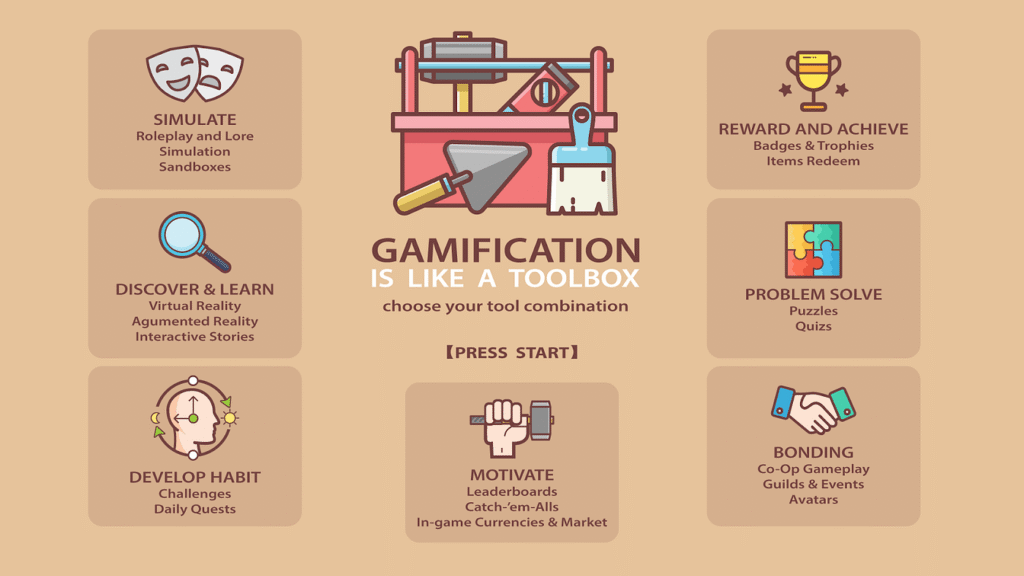Gamification in Business: Why Simulations Are the New PowerPoint

Introduction
Gamification in Business: Why Simulations Are the New PowerPoint Traditional PowerPoint slides serve their basic purpose, but in 2025 businesses are discovering a far more powerful tool: interactive simulations infused with gamification. These experiences replace passive presentations with hands-on engagement, enabling learners to act, react, and learn in dynamic, branded environments.
Why Simulations Beat PowerPoint

Active vs. Passive Learning
PowerPoint presentations often spell “passive learning,” where you’re mostly observing rather than interacting. But simulations flip that script: here, you’re in the driver’s seat—making decisions, facing consequences, and truly immersing yourself in the experience.
The results speak volumes. Research shows that in active learning environments—like simulations—students lower failure rates from 32% to 21%, and boost exam performance by around 6 points compared to traditional lectures. That’s not just theoretical—it’s real-world proof that when learners actively participate, they understand more, engage better, and apply knowledge with confidence.
Simply put, simulations don’t just engage—they empower. They transform “sit-and-listen” training into active, purposeful learning that sticks far beyond the slides.
Engagement Through Game Mech
Points, badges, leaderboards, and narratives aren’t just for fun—they’re powerful tools in gamification in business that can turn routine training into something memorable. Awarding points and badges activates the brain’s reward system, releasing dopamine and giving participants a real sense of accomplishment . Leaderboards tap into our natural hunger for challenge and recognition, encouraging healthy competition and social learning .
Adding narrative—the storyline that ties everything together—makes learning feel purposeful and relatable. In fact, storytelling in gamified training can boost retention rates by up to 65%, because people connect better with stories than with isolated facts.
Together, these elements forge a learning experience that’s not only more engaging but also more effective—people don’t just hear the material, they live it, internalize it, and carry it into real-world tasks.
Real-Time Application with Immediate Feedback
Simulations allow participants to jump into real‑world tasks—making decisions, seeing instant outcomes, and refining their actions on the spot. That immediacy does wonders for gamification in business learning. In fact, interactive simulations produce up to 90% knowledge retention, compared to just 5–10% from passive methods.
With real‑time feedback—a key strength of gamification in business—critical thinking improves fast. Learners trained in simulated environments report 40% faster skill acquisition and significantly fewer errors. Simultaneously, platforms show that instant analytics and corrective cues boost confidence by 72%, lift performance by 30%, and reduce training costs by about 23%.
Plus, data from platforms show that incorporating immediate analytics and corrective cues boosts confidence by 72%, performance by 30%, and reduces training costs by about 23% .
In short, simulations aren’t just flashier than slides—they provide real, measurable improvements. Immediate feedback transforms training from passive watching into active, effective learning.
Core Mechanics of Simulation Gamification

Based on the MDE framework (Mechanics → Dynamics → Emotions):
- Mechanics: Points, levels, challenges, virtual currencies
- Dynamics: Competition, collaboration, exploration
- Emotions: Motivational feedback, pride, excitement
These mechanics are key to understanding, as they create meaningful loops that naturally drive engagement and reinforce learning behavior.
Simulations in Action: Corporate Training

Platforms like MonsoonSIM leverage AI and gamification in business through gamified simulations to train business skills—strategy, finance, supply‑chain management—within realistic interactive settings.
A case study from a recognized technical university found that such simulations improve both knowledge and soft skills through repeated practice—a prime example of effective gamification in business.
Beyond Academia: Business Applications
- Employee Training: Simulated crisis training delivers safe, repeatable practice before real‑world application, showcasing at work.
- Customer Engagement: Brands use gamified simulations to boost loyalty and storytelling—another form of powerful gamification in business.
- Sales & Performance: Sales teams enter simulated markets, earn points, and strategize via leaderboards—dramatically enhancing motivation through gamification in business.
Proven Impact
- 89% of employees report improved productivity and satisfaction from gamified training—clear evidence of the benefits of gamification in business.
- Companies using see up to a 25% increase in productivity and 60% higher employee engagement.
- Caixa Bank achieved a 49% sales uplift in six months following gamified initiatives—a direct result of gamification in business.
- The global market is projected to reach approximately $30 billion by 2025.
Pitfalls to Avoid
- Surface‑Level Rewards: Simply flooding users with points—without thoughtful design—reduces impact.
- Forced Playwork: Coerced participation in can backfire—reducing engagement and trust.
- Poor Design & Imbalanced Play: Flawed loops or opportunities for cheating undermine effectiveness and credibility in gamification business.
- Ethical & Accessibility Risks: Transparency, data privacy, and inclusive design are essential for responsible.
The Future of Business Learning: Simulations Over Slides
- AI‑Personalization: Adaptive simulations tailor scenarios to individual performance—advancing strategies.
- Immersive XR Experiences: AR/VR simulations deepen realism—imagine virtual supply chains and crisis drills powered by gamification business.
- Intrinsic Motivation: The next phase of focuses on autonomy, mastery, and purpose—beyond mere external rewards.
Conclusion
Business gamification isn’t just about flash—it represents a real transformation. Gone are the days of static slides; today, immersive, game-powered simulations are leading the way.
With these, organizations see employees become more engaged, learning more effectively, and making real, lasting behavior changes.
The secret lies in crafting simulations that matter—ones with a clear purpose, emotional resonance, and true real-world relevance. When done right, PowerPoint becomes a relic of the past !
